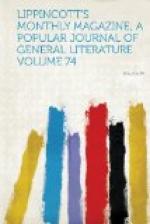A result of this is that a large number of wealthy commercial men, in despair of ever entering the charmed circle of county society, take up their abode in or near the fashionable watering-places, where, after the manner of those at our own Newport, they build palaces in paddocks, have acres of glass, rear the most marvelous of pines and peaches, and have model farms which cost them thousands of pounds a year. To this class is owing in a great degree the extraordinary increase of Leamington, Torquay, Tonbridge Wells, etc.—places which have made the fortunes of the lucky people who chanced to own them.
English ladies, as a rule, take a great deal of interest in the poor around them, and really know a great deal of them. The village near the hall is almost always well attended to, but it unfortunately happens that outlying properties sometimes come off far less well. The classes which see nothing of each other in English rural life are the wives and daughters of the gentry and those of the wealthier farmers and tradesmen: between these sections a huge gulf intervenes, which has not as yet been in the least degree bridged over. In former days very great people used to have once or twice in the year what were called “public days,” when it was open house for all who chose to come, with a sort of tacit understanding that none below the class of substantial yeomen or tradesmen would make their appearance. This custom has now fallen into disuse, but was maintained to the last by the Hon. Doctor Vernon-Harcourt, who was for more than half a century archbishop of York, and is yet retained by Earl Fitzwilliam at Wentworth House, his princely seat in Yorkshire. There, once or twice a year, a great gathering takes place. Dinner is provided for hundreds of guests, and care is taken to place a member of the family at every table to do his or her part toward dispensing hospitality to high and low.
During the summer and early autumn croquet and archery offer good excuses for bringing young people together, and reunions of this kind palliate the miseries of those who cannot afford to partake of the expensive gayeties of the London season. The archery meetings are often exceedingly pretty fetes. Somtimes they are held in grounds specially devoted to the purpose, as is the case at St. Leonard’s, near Hastings, where the archery-ground will well repay a visit. The shooting takes place in a deep and vast excavation covered with the smoothest turf, and from the high ground above is a glorious view of the old castle of Hastings and the ocean. In Devonshire these meetings have an exceptional interest from the fact that they are held in the park of Powderham Castle, the ancestral seat of the celebrated family of Courtenay. All the county flocks to them, some persons coming fifty miles for this purpose. Apropos of one of these meetings, we shall venture to interpolate an anecdote which deserves to be recorded for the sublimity of impudence which it displays. The




